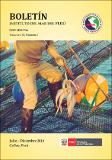Por favor, use este identificador para citar o enlazar este ítem:
https://hdl.handle.net/20.500.12958/3248Registro completo de metadatos
| Campo DC | Valor | Lengua/Idioma |
|---|---|---|
| dc.contributor.author | Sakai, Mitsuo | - |
| dc.contributor.author | Vijai, Dharmamony | - |
| dc.contributor.author | Yamashiro Guinoza, Carmen | - |
| dc.contributor.author | Wakabayashi, Toshie | - |
| dc.date | 2018 | Es |
| dc.date.accessioned | 2018-09-10T17:29:51Z | - |
| dc.date.available | 2018-09-10T17:29:51Z | - |
| dc.date.issued | 2018 | - |
| dc.identifier.citation | Bol Inst Mar Perú. 33(2) 2018: p. 153-159 | es_ES |
| dc.identifier.issn | 03787702 | - |
| dc.identifier.uri | https://hdl.handle.net/20.500.12958/3248 | - |
| dc.description.abstract | Egg masses were spawned by a jumbo squid Dosidicus gigas (mantle length 37.5 cm) held in a tank (500 L) on board the R/V Kaiyo Maru during a joint Japan-Peru cruise in Peruvian waters during December 2011– February 2012. Part of an egg mass was collected and incubated in an aquarium (10 L) maintained at 20 °C. The eggs had a unique jelly envelope surrounding the chorion. The diameter of the jelly envelope was more than twice the diameter of chorion. It remained clearly visible until the embryos reached developmental stage 18. Most of the eggs were fertilized and hatched (Stage 30) 6.5 days after spawning at 20 °C. | es_ES |
| dc.description.abstract | RESUMEN: Masas de huevos fueron desovadas por un calamar gigante Dosidicus gigas (longitud de manto 37,5 cm) mantenido en un tanque de 500 litros, a bordo del BIC Kaiyo Maru durante un crucero conjunto de Japón-Perú en aguas peruanas, entre diciembre 2011 y febrero 2012. Parte de la masa de huevos se recolectó e incubó en un acuario de 10 litros y conservó a 20 °C. Los huevos tenían una envoltura gelatinosa única alrededor del corion. El diámetro de la envoltura gelatinosa era más del doble del diámetro del corion, el que permaneció claramente visible hasta que los embriones alcanzaron la etapa de desarrollo 18. La mayoría de los huevos estaban fertilizados y eclosionaron (Etapa 30) 6,5 días después del desove a 20 °C. | - |
| dc.description.sponsorship | Instituto del Mar del Perú | es_ES |
| dc.language.iso | spa | es_ES |
| dc.publisher | Instituto del Mar del Perú | es_ES |
| dc.relation.ispartofseries | Boletín IMARPE;33(2), 2018 | - |
| dc.rights | info:eu-repo/semantics/openAccess | es_ES |
| dc.rights.uri | https://creativecommons.org/licenses/by/4.0/ | es_ES |
| dc.source | Instituto del Mar del Perú - IMARPE | es_ES |
| dc.source.uri | Repositorio Digital IMARPE | es_ES |
| dc.subject | Dosidicus gigas | es_ES |
| dc.subject | Calamar gigante | es_ES |
| dc.subject | Desove | es_ES |
| dc.subject | Cautiverio | es_ES |
| dc.subject | Ommastrephidae | es_ES |
| dc.subject | Embriones | es_ES |
| dc.title | Observations on embryos and embryonic development from an egg mass of the jumbo squid Dosidicus gigas spawned under captive conditions | es_ES |
| dc.title.alternative | Observaciones sobre embriones y desarrollo embrionario a partir de una masa de huevos de calamar gigante Dosidicus gigas desovada en cautiverio | es_ES |
| dc.type | info:eu-repo/semantics/article | es_ES |
| Aparece en las colecciones: | Boletín 33(2), 2018 | |
Ficheros en este ítem:
| Fichero | Descripción | Tamaño | Formato | |
|---|---|---|---|---|
| Boletin 33(2)3.pdf | Observations on embryos | 766,22 kB | Adobe PDF |  Visualizar/Abrir |
Este ítem está sujeto a una licencia Creative Commons Licencia Creative Commons

